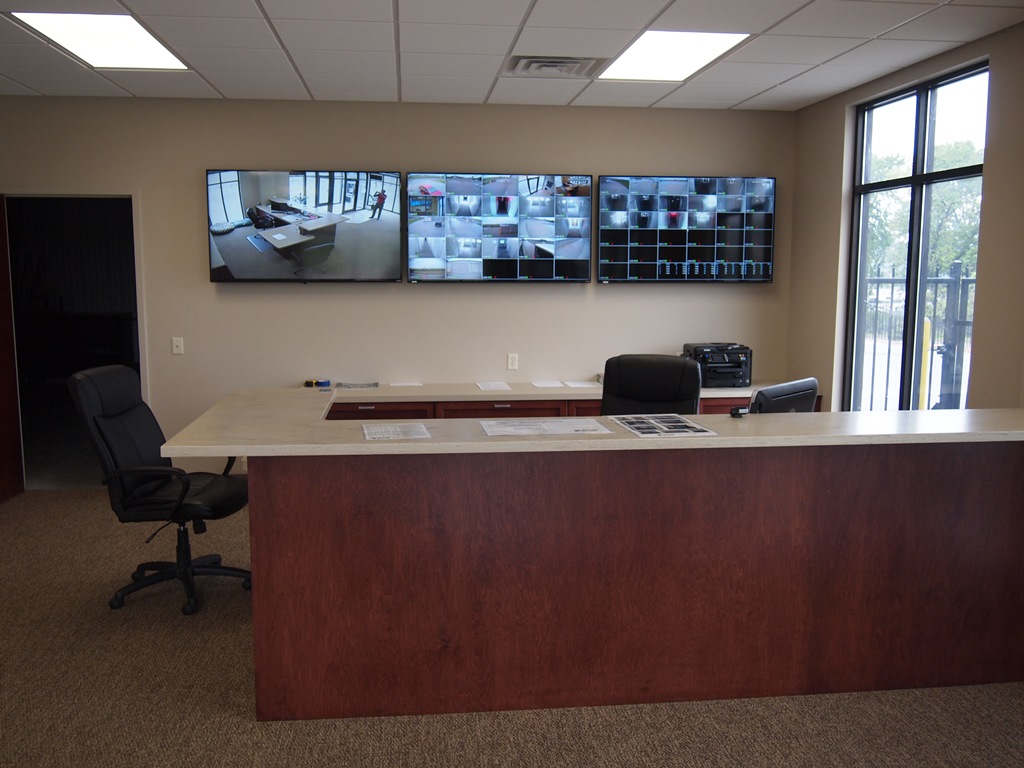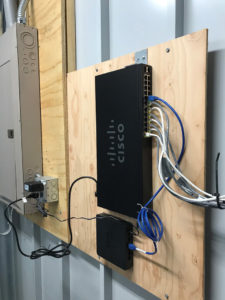
April 13, 2020 • Steve Hajewski, Marketing Manager and Self Storage investor
A few months ago, I discussed exterior lighting on this blog, since most of our clients ask us for a recommended light fixture. In this post I’m going to talk about the next question that usually comes up: Security cameras.
Whether or not you should install cameras is not even a question. Every self-storage facility should include plenty of cameras in their project. The cameras are relatively inexpensive, and they serve as a crime deterrent, sales tool, and occasionally help you figure what kind of antics your customers are actually up to when they think no one is looking. Occasionally they help you solve a crime.
Most customers will have professionals install the camera system, but it is something that you can consider doing yourself if you are a handy and tech savvy kind of person. If you are looking to have professional installation, look for a local installer so that in case service is needed, you have someone nearby that can help. Your state self-storage association can be a good resource to connect with an experienced vendor. If your project will include a gate or other controlled access, this vendor may also be able to install the cameras. Connect with these vendors before breaking ground so that they can work with you to determine locations for equipment cabinets, power requirements, and underground conduit locations. Plan not only for the current project but also for future phases.
If you plan to install the cameras yourself, you’ll likely purchase the equipment online. Here’s the basics that you’ll need to understand when planning and purchasing your system.
More pixels are better. More pixels allow you to zoom in more effectively to see license plates or faces. You may see this listed in terms identical to televisions, such as 1080p (good, that’s traditional high def resolution) or 4k (the new ultra high def format, 4 times the pixels of 1080) or you may also see it listed as a quantity of “megapixels” similar to how digital still cameras are sold. A “4k” picture is equivalent to 8MP.
The weakness of many cameras is capturing detailed images of moving objects, or low light pictures. To combat this, locate additional lights near the entrance of the facility. Most cameras go into an infrared mode when it gets dark. This light reflects off license plates so brightly that they become illegible. Extra lights can keep the cameras in daylight mode for better performance. Be sure to include cameras at gated entrances and keypads – this is an ideal opportunity to capture a good image of the stopped vehicle.
I have found that bundled packages provide the best value – such as 16 cameras and a NVR (network video recorder). Try to purchase a system with more cameras than you need so that you have at least one extra for troubleshooting or in case of damage. Purchasing single cameras can be costly, and you need to be absolutely sure that they are compatible with your video recording unit.
Cameras systems are usually offered with either cat5 (typical computer network wires) or coax (cable TV wire). Most cameras today are referred to as IP (Internet Protocol) cameras. I have found that dealing with IP cameras using cat5 wires is the easier. The wire is cheap and widely available in bulk spools. Adding the crimp on plugs is simple to do with an inexpensive tool. These cameras draw power from the same wire used for data via a standard called “Power over Ethernet” or “PoE” for short. The main limitation to keep in mind as you plan a system with this wiring: The wire can go up to 300’ max between devices. You can use network switches to extend the system, but the switch will need to provide PoE ports to power the cameras.

This wall mounted router and PoE switch provide power and data connection to an entire building’s worth of cameras connected to the video recorder (up to 300 feet away) by a single cat5 cable.
Here’s an example of how I wired up a recent addition to my property. I added two new buildings – each is roughly 10,000 sq ft of climate-controlled storage with some interior halls. I purchased a 16-camera system, with 8 cameras in one building directly connected to the recording unit. To connect to the other building, I ran a single cat5 cable to it, which is connected to a PoE network switch. There’s a wired router connected, because every network needs a router to manage traffic. Normally your internet router would serve this purpose, but in this stand-alone system I don’t have internet. The seven cameras in this building connect to the network switch. This arrangement allows me to get the distance I need for the cameras, and also meant I only needed to have a single cable underground. I am a fan of Cisco networking equipment. I have found that some off-brands don’t handle temperature extremes as well.
Speaking of underground cables – make sure that when you plan your system, bury separate conduits for data. Data and power connections should never share a conduit, and throughout the building try to put some distance between them to minimize interference.
More complex systems can use fiber optic converters or wireless network extenders to reach far away portions of a property. Wireless camera systems exist, but my personal opinion is that I don’t want to deal with anything battery powered (because that means maintenance) and I have also found that wired devices tend to be more reliable.
The video from those cameras needs to be saved somewhere. Most commercial systems will save it on a hard drive based recording unit, called “Network Video Recorder” or “Digital Video Recorder” aka a NVR or DVR. Most of these now offer remote access via a mobile app for remote viewing. In this arrangement the recorded video is on your device, not backed up on the cloud. The good thing about this arrangement is that there are not monthly fees such as you might find with a device like the ring doorbell. The bad part is that if the thieves also take the recording unit, your footage is lost. So, it’s a good idea for that recording unit to be in a secure location.
The recording unit will normally have a large hard drive that records until it is full, then begins to overwrite the oldest footage. On my own property, I have the system configured to record only when triggered by motion. A few of the cameras at the entrance are configured to trigger each other to ensure that nothing is missed. To avoid recording passing traffic on the street, settings in the admin panel of the system allowed me to mask of certain areas from the motion detection.
Lastly, be aware of the risk of power surges. Grounding the building itself can be helpful in preventing surges. There will be inevitable power failures, lightning strikes and who knows what else. Equipment should be connected to good quality surge protectors, and even better to use combination surge protector/battery backup units.
Share This!